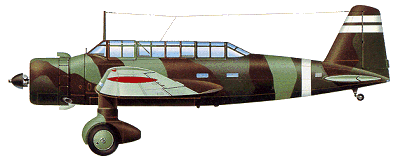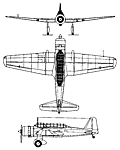 |
Mitsubishi Ki-30 ANN1937 |  |
| LIGHT BOMBER | Virtual Aircraft Museum / Japan / Mitsubishi |
 |
In May 1936 the Imperial Japanese Army issued its specification for a light bomber required to supersede the Mitsubishi Ki-2 and Kawasaki Ki-3 then in service. The Mitsubishi Ki-30 prototype that resulted was of cantilever mid-wing monoplane configuration with fixed tailwheel landing gear, the mam units faired and spatted, and powered by a 615kW Mitsubishi Ha-6 radial engine. Flown for the first time on 28 February 1937 this aircraft performed well, but it was decided to fly a second prototype with the more powerful Nakajima Ha-5 KAI radial engine. This aircraft showed some slight improvement in performance but, in any case, exceeded the army's original specification, so there was no hesitation in ordering 16 service trials aircraft. These were delivered in January 1938 and, two months later, the Ki-39 was ordered into production. First used operationally in China during 1938, the Ki-30s proved to be most effective, for in that theatre they had the benefit of fighter escort. The situation was very much the same at the beginning of the Pacific war, but as soon as the Allies were in a position to confront unescorted Ki-30s with fighter aircraft they immediately began to suffer heavy losses and were soon relegated to second-line use. The Allied codename 'Ann' was allocated to the Ki-30, but few were seen operationally after the opening phases of the war. A total of 704 had been built when production ended in 1941, 68 manufactured by the First Army Air Arsenal at Tachikawa, and many of these ended their days in a kamikaze role during the closing stages of the war.

|  COMPANY PROFILE | |||||||||||||||||||||||||||||||||||||||||||||||||||||||||||||||
 |

|

